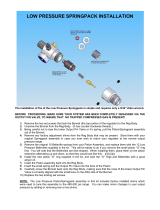
Instruction Manual
D103460X012
D3 Valve with easy-Drive Actuator
November 2013
4
For explosion-proof applications, install rigid metal conduit and a conduit seal no more than 457 mm (18 inches) from the
actuator. Personal injury or property damage may result from explosion if the seal is not installed.
Select wiring and/or cable glands that are rated for the environment of use (such as hazardous area, ingress protection, and
temperature). Failure to use properly rated wiring and/or cable glands can result in personal injury or property damage
from fire or explosion.
Wiring connections must be in accordance with local, regional, and national codes for any given hazardous area approval.
Failure to follow the local, regional, and national codes could result in personal injury or property damage from fire or
explosion.
CAUTION
When ordered, the valve configuration and construction materials were selected to meet particular pressure, temperature,
pressure drop, and controlled fluid conditions. Responsibility for the safety of process media and compatibility of valve
materials with process media rests solely with the purchaser and end-user. Since some body/trim material combinations
are limited in their pressure drop and temperature ranges, do not apply any other conditions to the valve without first
contacting your Emerson Process Management sales office.
To avoid product damage, inspect the valve before installation for any damage or any foreign material that may have
collected in the valve body. Also remove any pipe scale, welding slag, or other foreign material from the pipeline.
1. Before installing the control valve assembly, inspect it for any damage and for any foreign material that may have
collected in the valve body.
2. Clean out all pipelines to remove scale, welding slag, and other foreign materials.
3. The control valve assembly may be installed in any orientation, but normally the actuator is vertical above the valve.
Installthevalvesotheflowdirectionarrowonthesideofthevalveindicatesthedirectionoftheprocessflow.
4. Install the valve following local and national piping codes when they apply to the application. For screwed
connections, treat the external pipe threads with a good grade pipe compound. For flanged connections, use
suitable gaskets between valve and pipeline flanges.
5. If continuous operation is required during inspection or maintenance, install a three-valve bypass around the
control valve assembly.
Special Instructions for “Safe Use” and Installations in Hazardous
Locations
ATEX/IECEx
WARNING
To avoid static discharge from the enclosure, do not rub or clean the enclosure with solvents. To do so could result in an
explosion. Clean with a mild detergent and water only.
The enclosure is nonconducting and may generate an ignitioncapable level of electrostatic charges under certain extreme
conditions. The user should ensure that the equipment is not installed in a location where it may be subjected to external
conditions (such a s highpressure steam) which might cause a buildup of electrostatic charges on nonconducting surfaces.
Additionally, cleaning of the equipment shall only be done with a damp cloth.
To avoid damage to the enclosure, when screws are fully tightened into blind holes in enclosure walls, with no washer
fitted, at least one full thread shall remain free at the base of the hole.























